 |
See also Canberra Times article and Review | 
|
| Soloists | Choir |

SCUNA history » Concerts » 1965
Advertisement | Programme | Note
 |
See also Canberra Times article and Review | 
|
| Soloists | Choir |
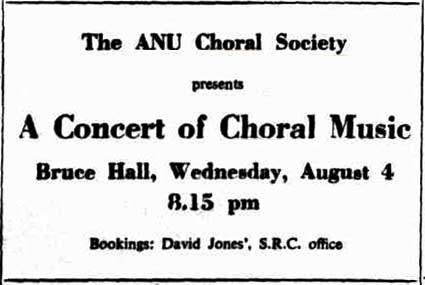
The ANU Choral Society
presents
A Concert of Choral Music
Bruce Hall, Wednesday, August 4
8.15 pm
Bookings: David Jones', S.R.C. office
The advertisement also appeared on Wednesday 28 July 1965.
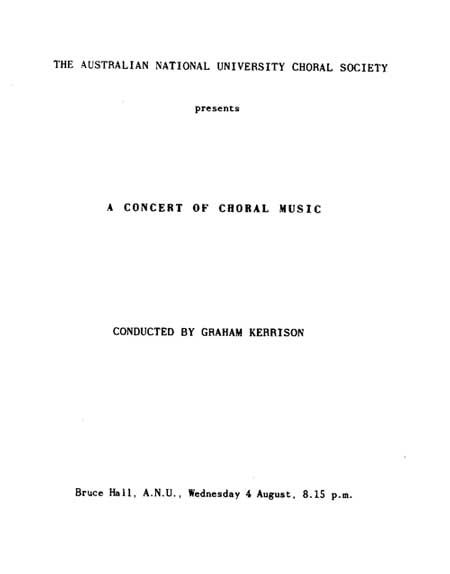
THE AUSTRALIAN NATIONAL UNIVERSITY CHORAL SOCIETY
presents
A CONCERT OF CHORAL MUSIC
CONDUCTED BY GRAHAM KERRISON
Bruce Hall, A.N.U., Wednesday 4 August, 8.15 p.m.

PROGRAMME |
||
| 1. | Anthems. | |
| Weelkes; | "Let thy merciful ears, 0 Lord". | |
| Taverner; | "Christe Jesu, Pastor Bone". | |
| Willaert; | "0 Magnum Mysterium". | |
| 2. | Gibbons. | |
| Te Deum, Benedictus, Magnificat and Nunc Dimittis from the Short Service. | ||
| 3. | Morley. | |
| Madrigalls to foure voyces. Since my tears and lamenting In every place April is in my mistress' face. |
||
| 4. | Byrd. | |
| Mass for five voices. | ||
| INTERVAL | ||
| 5. | Staden. | "Der Kuckuck und die Nachtigall". |
| 6. | Buxtehude. | "Das neugeborene Kindelein". |
| 7. | Kodaly. | "Matra Pictures". |
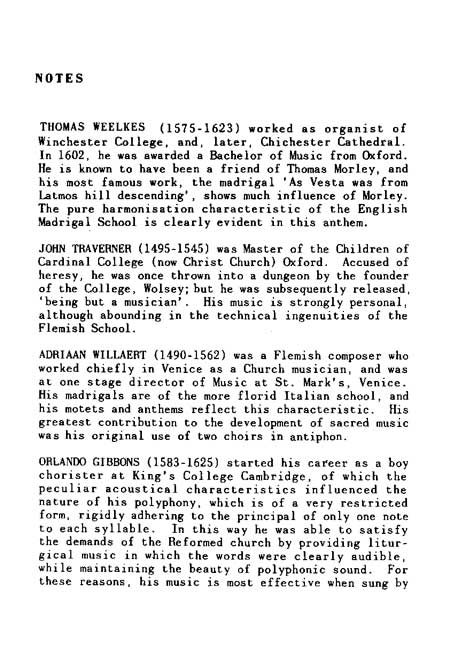
THOMAS WEELKES (1575-1623) worked as organist of Winchester College, and, later, Chichester Cathedral. In 1602, he was awarded a Bachelor of Music from Oxford. He is known to have been a friend of Thomas Morley, and his most famous work, the madrigal 'As Vesta was from Latmos hill descending', shows much influence of Morley. The pure harmonisation characteristic of the English Madrigal School is clearly evident in this anthem.
JOHN TRAVERNER [sic] (1495-1545) was Master of the Children of Cardinal College (now Christ Church) Oxford. Accused of heresy, he was once thrown into a dungeon by the founder of the College, Wolsey; but he was subsequently released, 'being but a musician'. His music is strongly personal, although abounding in the technical ingenuities of the Flemish School.
ADRIAAN WILLAERT (1490-1562) was a Flemish composer who worked chiefly in Venice as a Church musician, and was at one stage director of Music at St. Mark's, Venice. His madrigals are of the more florid Italian school, and his motets and anthems reflect this characteristic. His greatest contribution to the development of sacred music was his original use of two choirs in antiphon.
ORLANDO GIBBONS (1583-1625) started his career as a boy chorister at King's College Cambridge, of which the peculiar acoustical characteristics influenced the nature of his polyphony, which is of a very restricted form, rigidly adhering to the principal of only one note to each syllable. In this way he was able to satisfy the demands of the Reformed church by providing liturgical music in which the words were clearly audible, while maintaining the beauty of polyphonic sound. For these reasons, his music is most effective when sung by
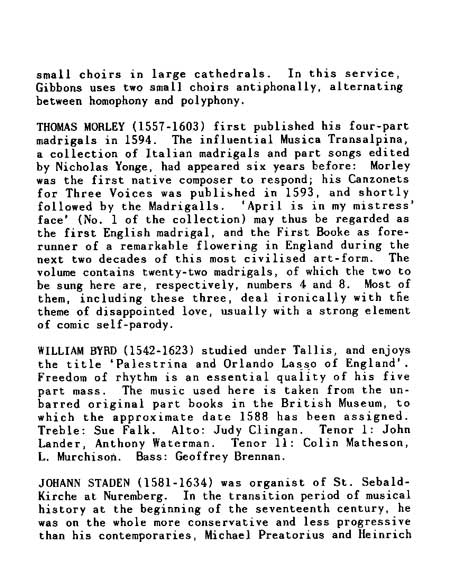
small choirs in large cathedrals. In this service, Gibbons uses two small choirs antiphonally, alternating between homophony and polyphony.
THOMAS MORLEY (1557-1603) first published his four-part madrigals in 1594. The influential Musica Transalpina, a collection of Italian madrigals and part songs edited by Nicholas Yonge, had appeared six years before: Morley was the first native composer to respond; his Canzonets for Three Voices was published in 1593, and shortly followed by the Madrigalls. 'April is in my mistress' face' (No. 1 of the collection) may thus be regarded as the first English madrigal, and the First Booke as forerunner of a remarkable flowering in England during the next two decades of this most civilised art-form. The volume contains twenty-two madrigals, of which the two to be sung here are, respectively, numbers 4 and 8. Most of them, including these three, deal ironically with the theme of disappointed love, usually with a strong element of comic self-parody.
WILLIAM BYRD (1542-1623) studied under Tallis, and enjoys the title 'Palestrina and Orlando Lasso of England'. Freedom of rhythm is an essential quality of his five part mass. The music used here is taken from the unbarred original part books in the British Museum, to which the approximate date 1588 has been assigned. Treble: Sue Falk. Alto: Judy Clingan. Tenor 1: John Lander, Anthony Waterman. Tenor 11 [sic]: Colin Matheson, L. Murchison. Bass: Geoffrey Brennan.
JOHANN STADEN (1581-1634) was organist of St. Sebald-Kirche at Nuremberg. In the transition period of musical history at the beginning of the seventeenth century, he was on the whole more conservative and less progressive than his contemporaries, Michael Preatorius [sic] and Heinrich
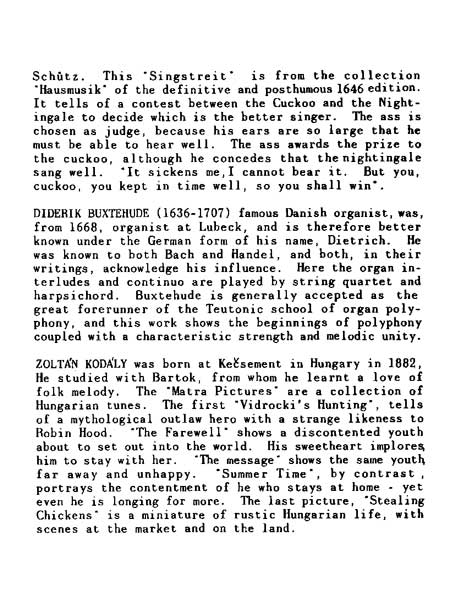
Schütz. This "Singstreit" is from the collection "Hausmusik" of the definitive and posthumous 1646 edition. It tells of a contest between the Cuckoo and the Nightingale to decide which is the better singer. The ass is chosen as judge, because his ears are so large that he must be able to hear well. The ass awards the prize to the cuckoo, although he concedes that the nightingale sang well. "It sickens me, I cannot bear it. But you, cuckoo, you kept in time well, so you shall win".
DIDERIK BUXTEHUDE (1636-1707) famous Danish organist, was, from 1668, organist at Lubeck, and is therefore better known under the German form of his name, Dietrich. He was known to both Bach and Handel, and both, in their writings, acknowledge his influence. Here the organ interludes and continuo are played by string quartet and harpsichord. Buxtehude is generally accepted as the great forerunner of the Teutonic school of organ polyphony, and this work shows the beginnings of polyphony coupled with a characteristic strength and melodic unity.
ZOLTÁN KODÁLY was born at Kečsement [sic] in Hungary in 1882. He studied with Bartok, from whom he learnt a love of folk melody. The "Matra Pictures" are a collection of Hungarian tunes. The first "Vidrocki's Hunting", tells of a mythological outlaw hero with a strange likeness to Robin Hood. "The Farewell" shows a discontented youth about to set out into the world. His sweetheart implores him to stay with her. "The message" shows the same youth far away and unhappy. "Summer Time", by contrast, portrays the contentment of he who stays at home - yet even he is longing for more. The last picture, "Stealing Chickens" is a miniature of rustic Hungarian life, with scenes at the market and on the land.
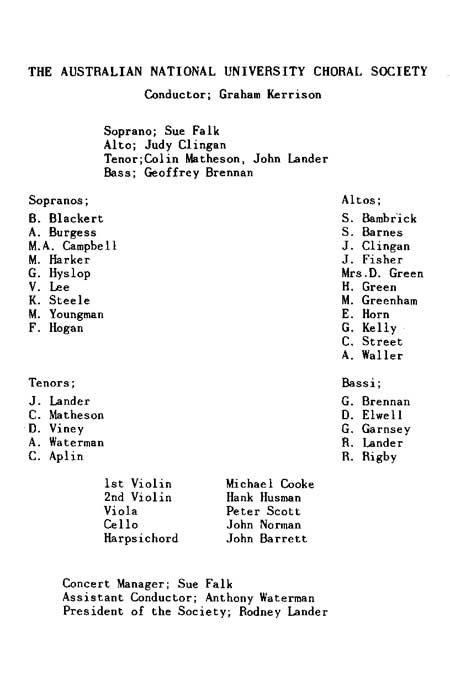
| THE AUSTRALIAN NATIONAL UNIVERSITY CHORAL SOCIETY | ||
| Conductor; Graham Kerrison | ||
| Soprano; Sue Falk Alto; Judy Clingan Tenor; Colin Matheson, John Lander Bass; Geoffrey Brennan |
||
| Sopranos; B. Blackert A. Burgess M.A. Campbell M. Barker G. Hyslop V. Lee K. Steele M. Youngman F. Hogan |
Altos; S. Bambrick S. Barnes J. Clingan J. Fisher Mrs. D. Green H. Green M. Greenham E. Horn G. Kelly C. Street A. Waller |
|
| Tenors; J. Lander C. Matheson D. Viney A. Waterman C. Aplin |
Bassi; G. Brennan D. Elwell G. Garnsey R. Lander R. Rigby |
|
| 1st Violin Michael Cooke 2nd Violin Hank Husman Viola Peter Scott Cello John Norman Harpsichord John Barrett |
||
| Concert Manager; Sue Falk Assistant Conductor; Anthony Waterman President of the Society; Rodney Lander |
||
1Source: Advertising. (1965, July 31). The Canberra Times (ACT : 1926 - 1995), p. 16. Retrieved May 17, 2013, from http://nla.gov.au/nla.news-article105763856